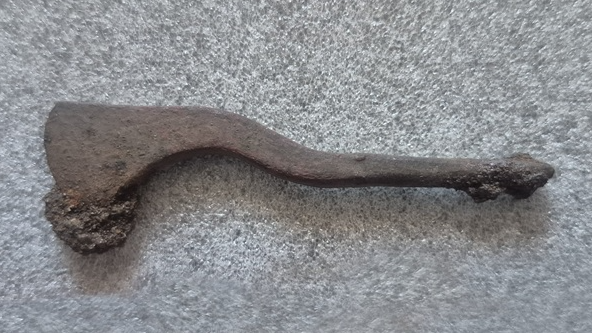Archaeologists in Poland have discovered a rare iron tool used by the Celts to perform cranial surgery 2,300 years ago.
The hand-held artifact was discovered at the Celtic site Wisa Góra in the Mazovia region of central-eastern Poland.
“The manufacturing technique and precision of the ironwork is indicative of Celtic metallurgy,” Bartłomie Kaczynski, an archaeologist at Warsaw’s National Archaeological Museum, told Live Science in an email, adding that the ironwork was likely used to trepanate human skulls.
you may like
Derived from the Greek word meaning “to make a hole,” trepanation is a type of cranial surgery practiced for at least 5,000 years, until the early 19th century, in many cultures around the world, including present-day Spain, Israel, and Bolivia.
A 2007 study published in the journal Neurosurgical Focus found that although there were several methods of trepanation, most Celts appear to have used the “traditional scraping technique of trepanation,” with only a few Celtic settlements practicing “drill trepanation.”
“The Celts practiced trepanation, as shown by the individual tools found in the tombs,” Kaczynski said. “It appears that these surgeries had medical as well as magical purposes.”
But so far, the remains of those who underwent surgery at Wisa Gula have not been found.
The team said the presence of the Celts, fierce warriors from mainland Europe who sacked Rome, was somewhat surprising because Huisa Gora is the most northeastern Celtic site ever discovered in Europe.
Kaczynski and his team have been conducting new archaeological excavations for two years at Wisa Góra, which was first excavated in the 1970s.
In 2024, archaeologists discovered hundreds of artifacts, including a rare Celtic helmet made of thin sheets of bronze. And during excavations in 2025, the team discovered Celtic brooches, spearheads, iron axes, and a number of other metal objects related to horseback riding.
you may like
Kaczynski said the trepanation instruments, which were discovered at the same site as the helmet this spring at the site, are even rarer than the helmet, as only a few of these surgical instruments have been found at Celtic sites. This particular instrument, featuring a blade that transitions into a spike and was probably originally fixed to a wooden handle, is a type of ancient scalpel.
Kaczynski told Polish Science that the presence of the iron scalpel means that the Celtic people who settled in the area likely included individuals with specialized medical and ritual knowledge, as well as blacksmiths who could make the tools found at Wisa Góra.
Excavations at Wisa Góra have so far revealed that it was a fortified settlement before the arrival of the Celts in the 4th century. But once the Celts arrived, Kaczynski said, “the traces of bronze and iron metallurgy, unique imports, and fragmented bronze and amber items all indicate that the settlement was an important center of trade.”
Kaczynski told Live Science in 2024 that amber was a valuable material in the Mediterranean world at the time, and that the Celts may have fortified Zissa Gora to protect their place on the Amber Trail.
Celtic Quiz: Test your knowledge about these ferocious tribes once described by Julius Caesar
Source link

